Donations Make us online
No smart lighting solution is as elegant as having smart light switches and dimmers embedded in your walls. Sure, you could screw smart bulbs into your fixtures, or plug a couple of lamps into smart plugs and call it a day, but if the light fixture in question is controlled by a dumb switch, you’ll never be able to control that smart bulb if the switch is in the off position.
While they can be a pain to install—hire an electrician if you’re not comfortable doing it yourself—once it’s installed, a smart light switch lets you turn your lights on and off according to a schedule, with a smartphone app, and—with the installation of accessories—in response to voice commands, motion, or even your location (provided you have your smartphone with you).
Here are our top picks in smart dimmers, followed by a guide to the features and terminology you’ll encounter when you shop for one.
Updated June 14, 2023 to add a link to our news story about Vivint adding a line of smart switches and smart bulbs to its smart home service offerings.
Best smart dimmer — Lutron Diva Smart Dimmer (and its Caséta ecosystem)
Pros
- Part of the robust Lutron Caséta smart home ecosystem
- Broadly compatible with other smart products and systems
- Doesn’t depend on a neutral wire
Cons
- You must have Lutron’s Caséta Smart Hub wired to your home network
- Lutron’s uncertain stance on Matter
Price When Reviewed:
$69.95
The Lutron Caséta ecosystem, of which the Diva Smart Dimmer is a part of, is much less open than the other big three smart lighting platforms: Wi-Fi, Z-Wave, and Zigbee, and we’ve not yet learned what plans Lutron has for the new Matter smart home standard (althought Lutron is a member of the Connectivity Standards Alliance that defined Matter). But in the grand scheme of things, we don’t believe that’s a reason to avoid Lutron’s smart lighting products. Caséta is so inclusive of third-party smart home products–Amazon Alexa, Apple HomeKit, Google Assistant, IFTTT, Samsung SmartThings, and even Sonos speakers–that there’s little reason for concern that buyers will end up on a disconnected island. The Diva Smart Dimmer itself is an excellent product and we highly recommend it.
Read our full
Lutron Diva Smart Dimmer review
Best budget-priced smart dimmer — Kasa Smart Wi-Fi Dimmer Switch, Motion-Activated (model ES20M)
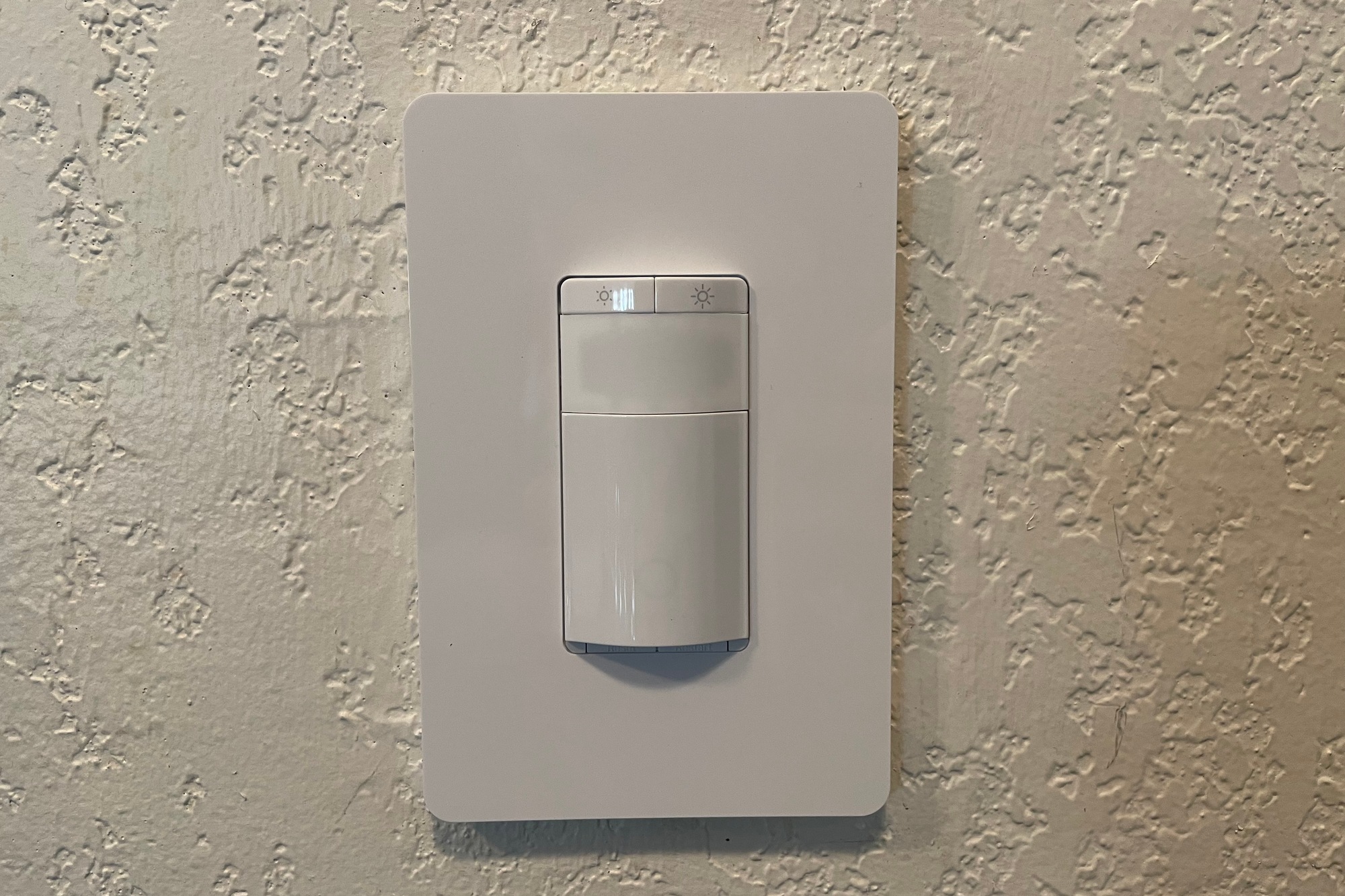
Pros
- Endlessly tweakable motion-sensing options
- Wiring design makes for easy installation
- Attractive design aesthetic
Cons
- Requires a neutral wire
- Kasa app needs to be modernized
- Motion sensing range is a bit weak
Price When Reviewed:
$39.99
TP-Link’s motion-activated Kasa Smart Wi-Fi dimmer gives you immense control over how its motion- and light-sensing features work. Why reach for a light switch when you can have the switch turn on the light as you approach? And TP-Link’s dimmer is remarkably low priced–it was selling for $30 at the time of our review ($10 less than its $40 list price). It’s remarkably easy to install, but it does require a neutral wire, which will be a non-starter for some homeowners.
Read our full
Kasa Smart Wi-Fi Dimmer Switch, Motion-Activated (model ES20M) review
Best Wi-Fi smart switch/dimmer — GE Cync Dimmer + Motion Smart Switch

Pros
- Motion sensing works great
- Very easy to set up
- Can control Cync smart bulbs even if they aren’t wired to the switch
- Available in a version that doesn’t require a neutral wire
Cons
- Ugly industrial design
- Motion sensing settings aren’t always intuitive
- Pricey for this category
Price When Reviewed:
$74.99
This isn’t the prettiest dimmer on the market, but GE Lighting’s Cync Dimmer + Motion Sensor Switch sure packs the features. And if you happen to own GE Lighting’s Cync smart bulbs, the switch can also control them even if they’re not wired to the dimmer. Being a Wi-Fi device, this dimmer switch doesn’t require the presence of a smart home hub or any other bridge to your home network. An onboard motion sensor can turn the light switch on when the room is occupied, and an ambient light sensor will stop that from happening if there’s enough daylight that the extra light isn’t needed. There’s now also a 3-wire version of this product that doesn’t require a neutral wire
Read our full
GE Cync Dimmer + Motion Smart Switch review
Best Zigbee smart switch/dimmer — Jasco Enbrighten Zigbee In-Wall Smart Dimmer

Pros
- SimpleWire technology effectively eases installation hassles
- Slim profile might help some users with space management in the electrical box
- Smooth installation and no operational trouble
Cons
- Requires a neutral wire
- Broadsheet user manual will cause your eyes to glaze over
- Dependent on a third-party smart home hub with a Zigbee radio
If you’ve settled on Zigbee as your smart lighting protocol of choice—and it’s certainly not a bad one if you have a SmartThings hub, an Amazon Echo with an integrated smart home hub, or the like–allow us to recommend Jasco’s Enbrighten Zigbee In-Wall Smart Dimmer. It not only has a slimline design that isn’t tough to shove back into the box when you install it, it has enough onboard intelligence to distinguish the line wire from the load wire, so you don’t need to worry about mixing them up if you’re doing the work for yourself. This smart dimmer is affordably priced, too
Read our full
Jasco Enbrighten Zigbee In-Wall Smart Dimmer review
Best Z-Wave smart switch/dimmer — Leviton Decora Z-Wave Plus (model DZ6HD)
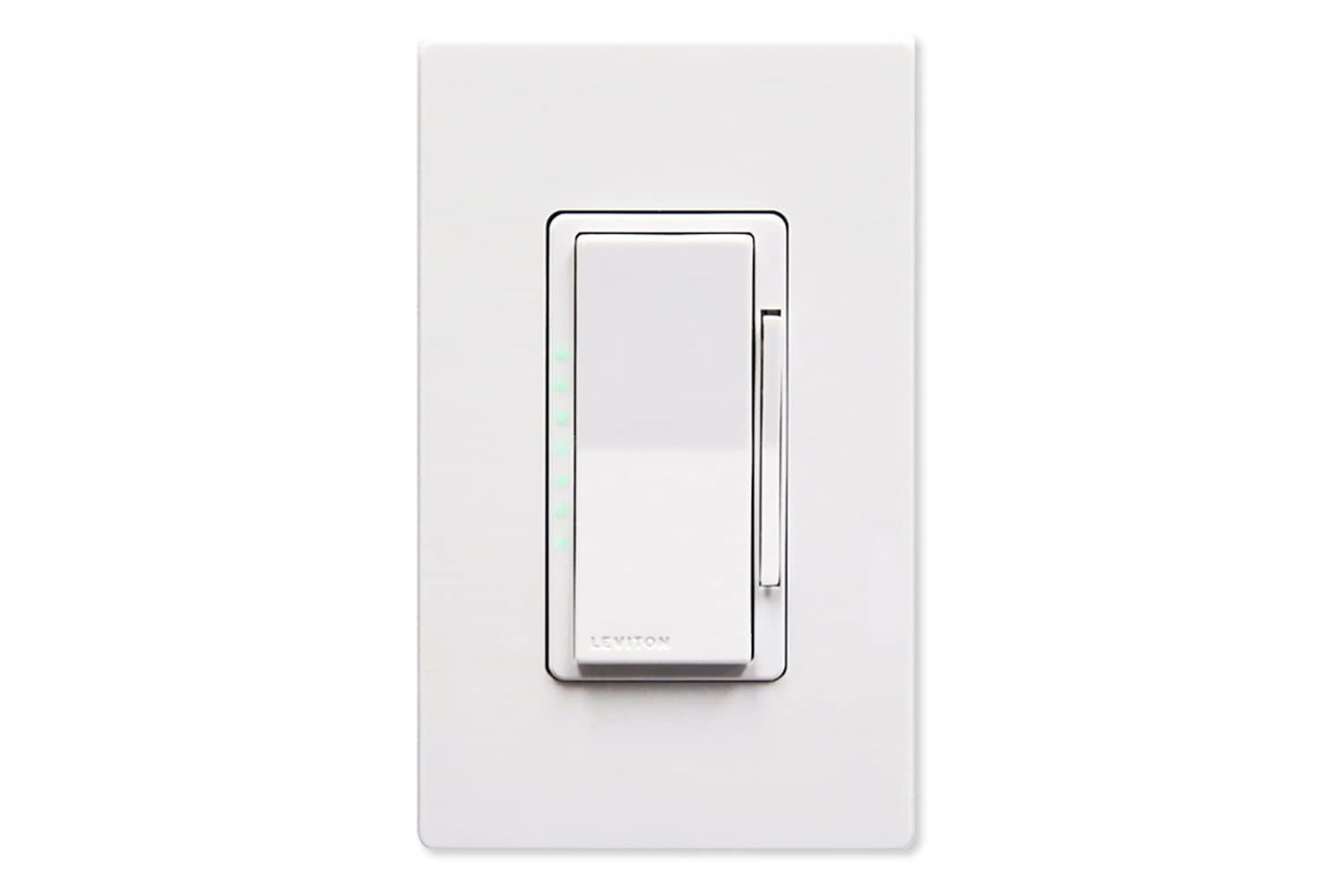
Pros
- Leviton delivers best-in-class reliability
- Z-Wave technology is widely supported by professional and DIY smart home hubs alike
- Z-Wave is a mature and robust self-healing mesh network technology
Cons
- Requires a Z-Wave-compatible smart home hub
- Requires a neutral wire
- No Z-Wave-to-Matter bridges have been announced as of October 2022
Putting this roundup together exposed a hole in our editorial coverage. I’ve had Leviton’s Decora Smart Z-Wave switches and dimmers (along with other brands of Z-Wave switches) installed in the smart home I built the house in 2007), but we’ve never officially reviewed them. That said, Leviton’s Z-Wave lighting controls are among my favorites; so, while TechHive hasn’t officially reviewed Leviton’s product, I have deep personal experience with it and recommend it strongly. All that said, if Matter succeeds in becoming the de facto smart home standard, you’ll need a Z-Wave-to-Matter bridge, and none have been announced yet.
Most sophisticated smart switch/dimmer — Brilliant Control
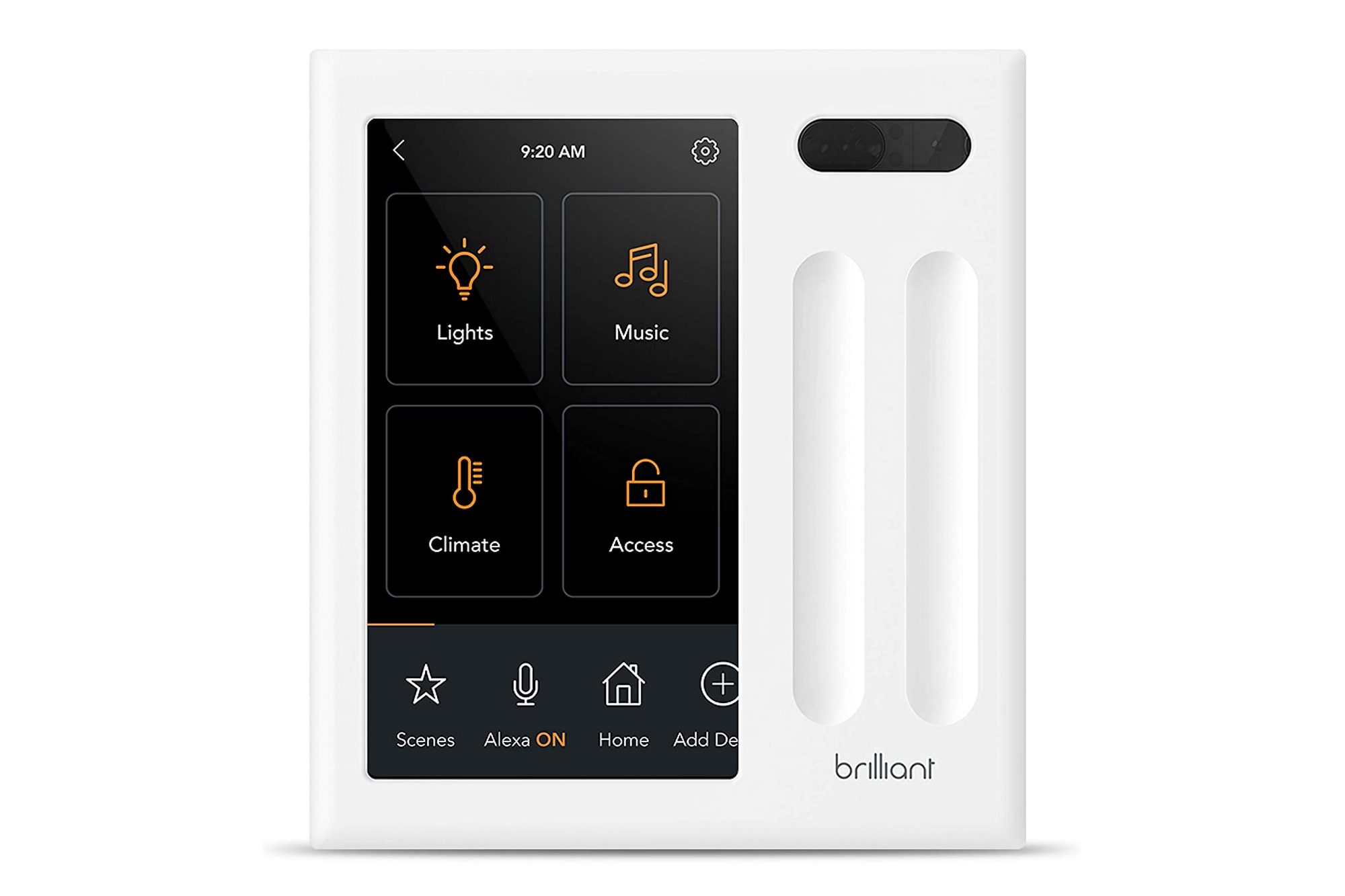
Pros
- Touchscreen and built-in camera adds incredible flexibility
- Alexa onboard; plus great third-party integrations, including Ring and Apple HomeKit
- Impressive build quality
Cons
- Devilishly complex to set up properly (at least in my house)
- Very expensive: $399 for single switch panel, $449 for a 2-switch panel, $499 for a 3-switch panel
Price When Reviewed:
$449
Brilliant was one of the first companies to integrate a touch panel with a smart switch, and this smart dimmer has some very cool tricks up its sleeve, ranging from being able to stream video from a doorbell camera to controlling a Sonos multi-room audio system. Most recently, Brilliant announced compatibility with Resideo’s Lynx and Vista home security systems, enabling users of those systems to arm and disarm their security system from a Brilliant device or from the Brilliant mobile app.
Read our full
Brilliant Control review
Best multi-function smart switch/dimmer — Leviton Decora Smart Voice Dimmer with Amazon Alexa (model DWVAA)

Pros
- Alexa with no footprint, exposed power cord, or wall wart
- No smart home hub required
- Lots of options for lighting control and integration with other smart home devices
Cons
- Wi-Fi dependent, so range could be an issue
- Operates on 2.4GHz networks only
- Doesn’t support Alexa’s whisper mode
- Tinny speaker, and it can’t be paired with a Bluetooth speaker
- No HomeKit or Google Assistant support
Just how many features can you cram in a single-gang light switch? Leviton squeezes a Wi-Fi radio, a dimmer switch, and an entire Amazon Alexa-compatible smart speaker into its Decora Smart Voice Wi-Fi Dimmer with Alexa. Yes, Ecobee pulled off a similar trick earlier, but with an on/off switch, not a dimmer. Leviton also has a deeper catalog of other Wi-Fi components—switches, dimmers, ceiling fan controllers, multi-button controllers, and more—to go with it. Apple HomeKit and Google Home users should look elsewhere.
Read our full
Leviton Decora Smart Voice Dimmer with Amazon Alexa (model DWVAA) review
You’ll need to make a raft of decisions before you choose which smart switches to install in your home, and your choices will be influenced by everything from the type of wiring in your walls to what flavor of smart home system you have now or plan to install later. Here’s what you need to know in roughly the order you’ll need to decide.
Neutral wire requirement: The vast majority of smart switches and dimmers require the presence of a neutral wire—in addition to line (power from the circuit-breaker panel), load (power to the light to be controlled), and ground wires—in the electrical box inside the wall. Smart switches have radios that must be constantly powered, and the neutral wire is usually what supplies that juice. While all homes have neutral wires, many older homes don’t have a neutral wire in every box. If you’re not sure if there’s a neutral wire at the location you want to install a smart switch, we have a how-to story here that will help you figure it out. If you don’t have a neutral wire, Lutron’s Caséta smart dimmer and the GE Cync Dimmer (3-wire version) are among the few that do not require one.
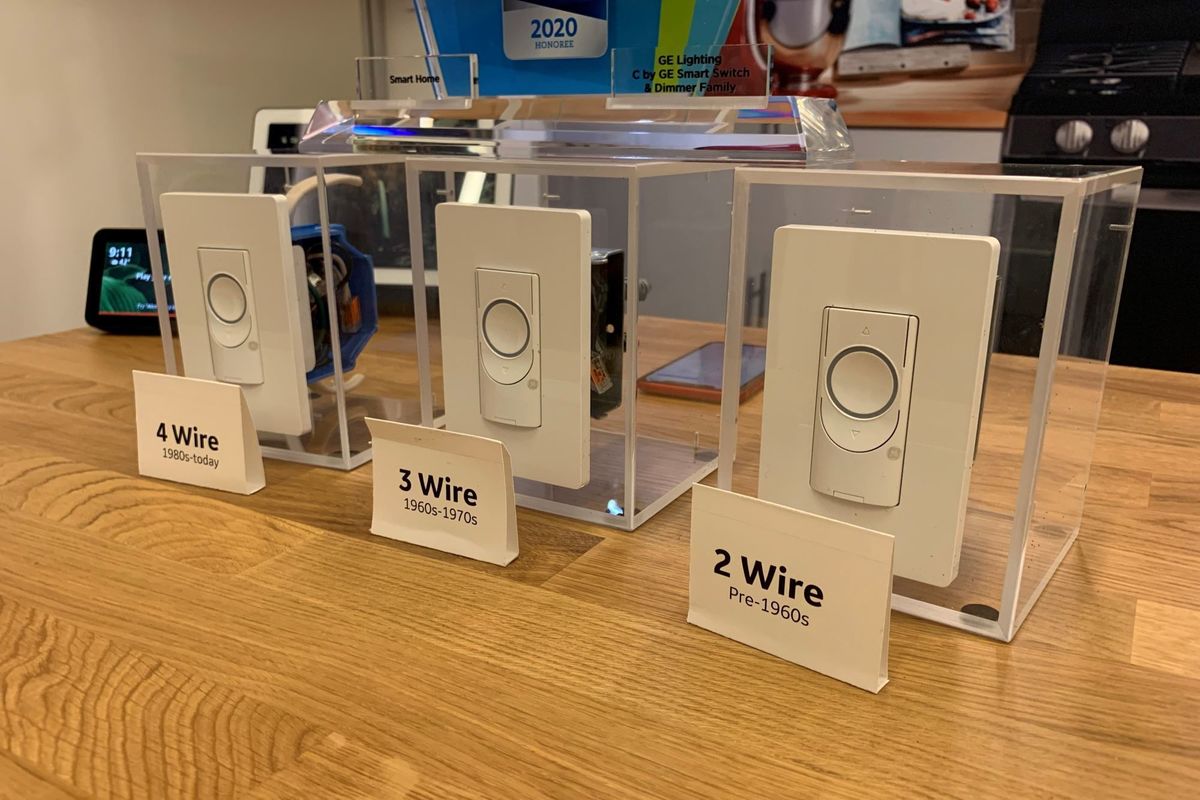
Most smart switches depend on the presence of a neutral wire to supply energy to their radios, but many homes built prior to the 1980s don’t have a neutral wire in every box. GE Cync and Lutron Caséta are among the few smart switches that don’t depend a neutral wire.
Single- or multi-pole: If the light you wish to control is connected to just one switch, then you’ll need to replace it with a single-pole smart switch. If more than one switch controls that load—switches on opposite sides of a room, for example—then you’ll need to replace it with a multi-pole smart switch. This typically means that you’ll also need to buy a companion switch or switches for the other end(s) of the circuit. There are a few exceptions to this rule, so check the documentation accompanying whichever smart switch you decide to buy before you install it.
Control protocol: You’ll undoubtedly want to control your smart lighting with your smartphone or tablet, and most people will also want to turn lights on and off with voice commands spoken to a smart speaker, such as an Amazon Echo or a Google Home. But to do that, the smart switch you buy must have some way of connecting to your home network (which explains why Bluetooth smart switches can’t talk to smart speakers).
Some smart switches connect directly to your Wi-Fi network, while others require a bridge to your router. If you’ve invested in a smart home system—Samsung SmartThings, Hubitat Elevation, Vivint Smart Home, or any other ecosystem—you’ll want to make sure that the smart switch you buy is compatible with it. These are the most common communication protocols you’ll encounter.
Bluetooth This type of smart switch is controlled directly by an app on your smartphone or tablet. Bluetooth smart lighting is simple, because you don’t need a hub or a connection to your home network. That isolation also makes it secure, because you must be within about 30 feet of the switch to pair with it. On the other hand, authorized users also must be within 30 feet of a Bluetooth switch to control it, and you can’t control the switch when you’re away from home (although most Bluetooth switches can be controlled according to a pre-programmed schedule). The other major limitation of Bluetooth switches is that they can’t be controlled by smart speakers or smart home hubs, which generally rely on one of the other wireless protocols described here.
Lutron Clear Connect This is a proprietary wireless protocol used by Lutron Caséta Wireless smart home devices, including switches, dimmers, ceiling fan controllers, occupancy sensors, motorized shades, and battery-powered remote controls. You can also control a limited number of third-party devices with Lutron’s app—ranging from thermostats to Wi-Fi speakers—and incorporate them into smart home “scenes.” Clear Connect operates independently of your Wi-Fi network, but you must hardwire a Lutron Smart Bridge to your router to use it. You can control Lutron Caséta devices via Lutron’s app, with voice commands spoken to smart speakers, and from mobile devices anywhere you have broadband access. Some smart home systems, including Samsung SmartThings, can also incorporate Lutron’s smart home products.
Wi-Fi This is a relatively recent trend in smart switches, probably because Wi-Fi hasn’t always been the best means of blanketing a home with connectivity. Mesh Wi-Fi routers, however, have gone a long way to remedying that problem. The attraction of Wi-Fi smart switches is that they don’t require a hub or a bridge to connect to your router. Once installed, they can be controlled with smart speakers, the manufacturer’s own app, and many smart home systems (check compatibility before you buy).
Z-Wave This is a wireless mesh network technology in which each node on the network is also a repeater that can forward commands on to other Z-Wave devices nearby. It operates in the unlicensed 800- to 900MHz radio spectrum (specifically, 908.42MHz in North America). Its low power requirement means it can be incorporated into battery-operated devices that cannot be plugged directly into an electrical circuit, including door/window sensors, smart locks, water leak detectors, and motion sensors in addition to smart dimmers and switches. You’ll need a smart home hub, such as a Samsung SmartThings, to act as a bridge to your Wi-Fi network. Z-Wave is supported by a raft of smart home product developers, including Leviton, Jasco, Aeotec, and others.
Zigbee This wireless mesh network technology is very similar to Z-Wave, but it operates in the unlicensed 2.4GHz radio spectrum (same as single-band Wi-Fi). Like Z-Wave, Zigbee has a lower power requirement and can be incorporated into both battery and line-powered devices, ranging from sensors to smart switches. And as with Z-Wave, you’ll need a smart home hub or some other kind of bridge to connect Zigbee devices to your home network. This could be something as simple as an Amazon Echo Plus, which has an integrated Zigbee radio, or it could be on the order of a Samsung SmartThings hub, which has both Zigbee and Z-Wave radios onboard.
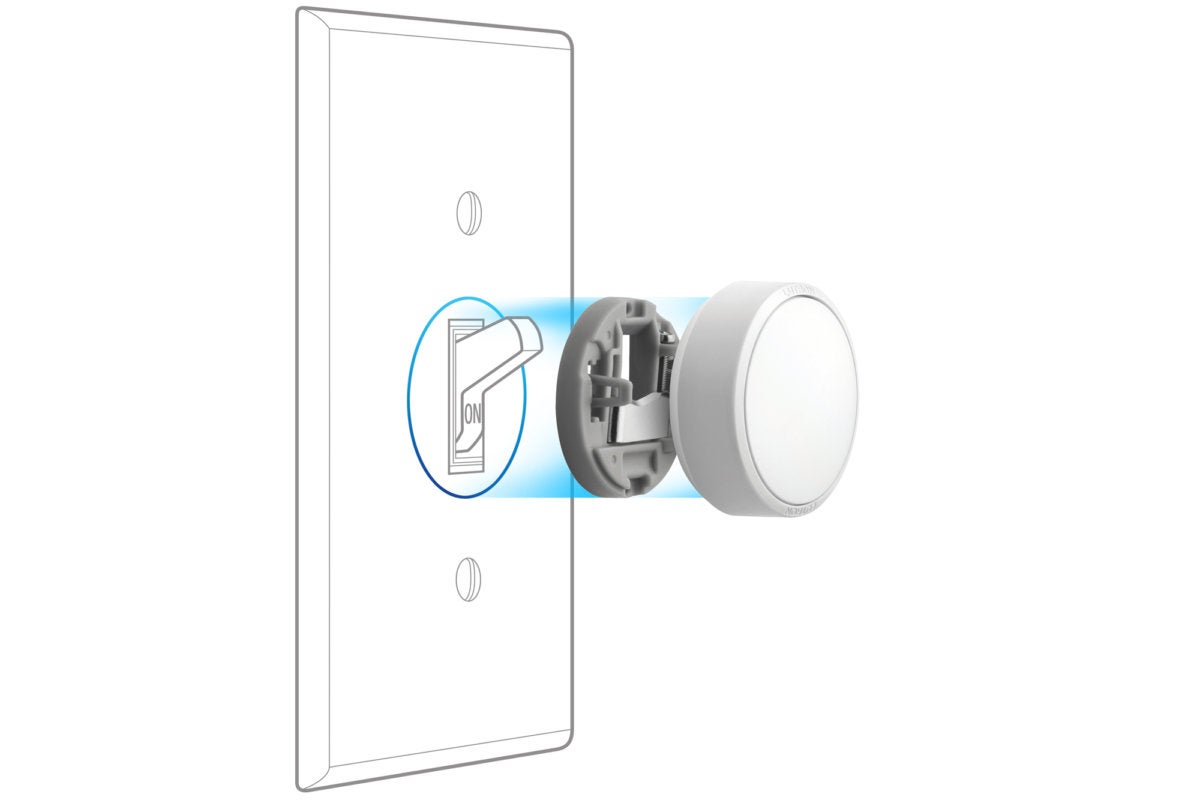
As you can see in this illustration, it’s not necessary to remove the cover plate to install the Aurora on the switch, but it only works with toggle switches.
Signify’s Philips Hue bridge is another solution, but it’s generally limited to supporting Philips Hue smart bulbs and accessories. Zigbee is widely support among smart dimmer manufacturers, including Jasco, Sinopé, and Sengled. Lutron also makes an ingenious Zigbee gadget for Philips Hue smart bulbs—the Lutron Aurora—that attaches to an old-fashioned toggle light switch and not only prevents the switch from being turned off (instantly rendering a Philips Hue smart bulb dumb), but it wirelessly controls all the Hub bulbs connected to that switch—complete with a rotary knob for dimming and brightening those bulbs and turning them on or off.
Switch mechanism: Since most people control smart switches and dimmers with voice commands, they soon discover that they rarely physically interact with the devices in their walls. But you’ll want to consider the type of mechanism the smart switch uses if for no other reason than to ensure its aesthetic matches the rest of your home. These are the most common types you’ll encounter.
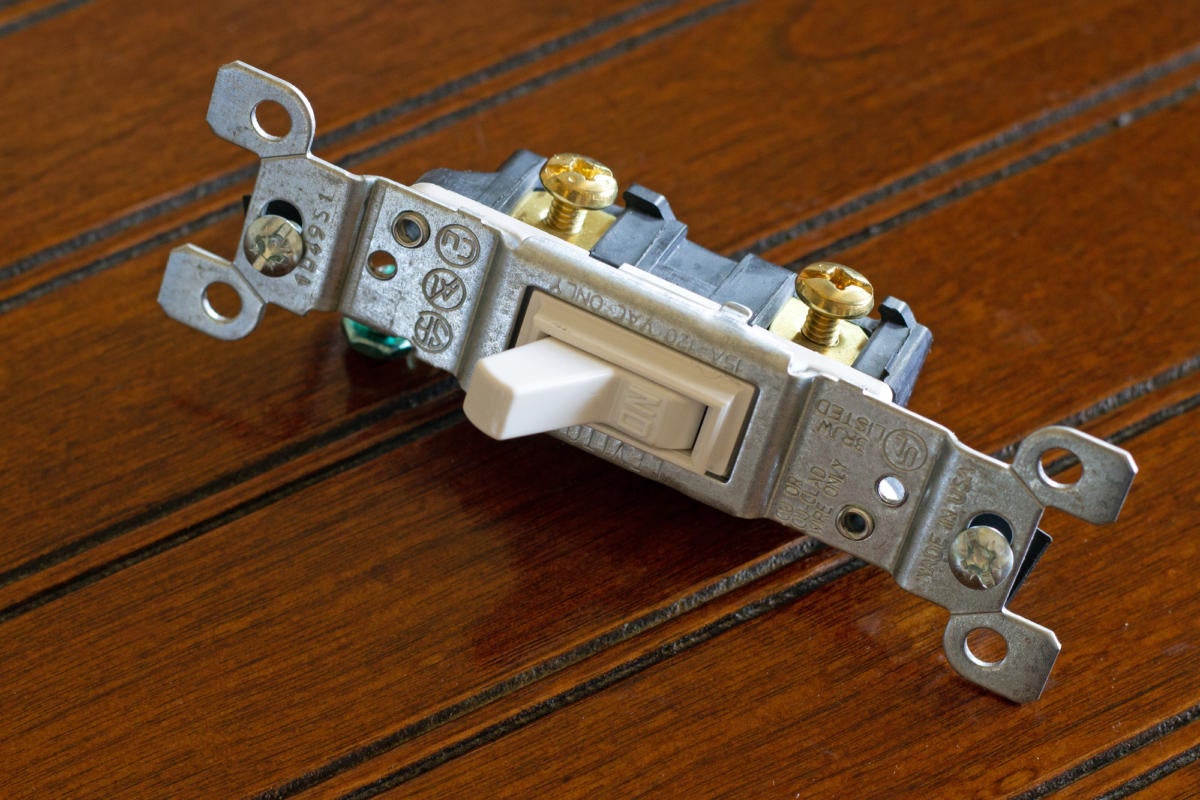
Relatively few manufacturers make smart switches that look like this type of old-fashioned toggle switch.
- Rocker (aka paddle) This type of switch has a wide plastic panel that rocks back and forth when pressed to turn the controlled load on and off (one side of the switch raises when the other is depressed). These modern-looking switches hug the wall and are very easy to operate. Since a command issued over the air will override whatever physical state the switch is otherwise in, smart rocker switches typically don’t physically flip, so there’s no confusion when you see a lit bulb when the switch is ostensibly in the “off” position. A smart dimmer switch might have a secondary control—a vertical slider or a horizontal rocker—for adjusting brightness
- Toggle A toggle switch operates by moving a lever up and down (flipping the lever up turns the controlled light on, and flipping it down turns it off). These types of switches tend to look more old-fashioned than rocker switches, but you can find smart versions of them if you want something that looks like the other switches you have in your walls. As with smart rocker switches, they generally don’t completely change physical appearance when switched on or off.
- Touch High-end smart switches and dimmers feature touch-sensitive surfaces. Typically made of glass, touch-sensitive smart switches and dimmers are typically backlit by one or more LEDs that can be multiple colors. The touch sensitivity can be as simple as touch to turn the switch on and touch again to turn it off, or they can be as complex as displaying a user interface that supports finger swipes for calling up different lighting scenes or control elements. Needless to say, these types of smart switches and dimmers cost considerably more than simple plastic devices.
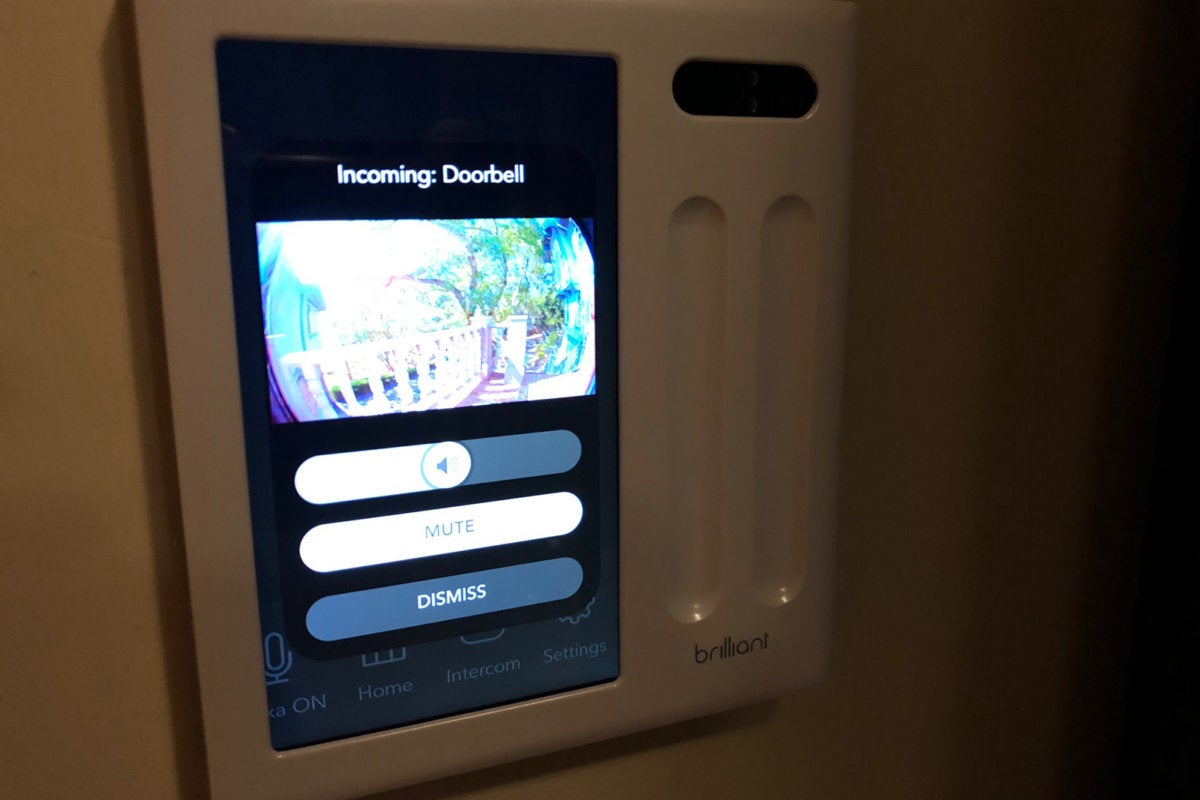
Brilliant’s touchscreen panel lets you see and talk with a person at your door when a visitor activates your Ring Video Doorbell.
Wiring connections: Smart switches and dimmers tend to be larger than their dumb counterparts, so you should consider how the new switch will fit in your existing electrical box. This is particularly important if you’re installing multiple smart switches next to each other in a single box. Remember that there will be at least four wires to deal with—line, load, neutral, and ground—and that there will also be a traveler wire if you’re dealing with a multi-pole circuit. It can be challenging to stuff all those wires and the new switch back into the box. These are the most common types of electrical connections you’ll encounter in smart switches.
- Backstabs These are holes in the back of the switch into which you’ll push (“stab”) the appropriate solid copper wires coming out of the wall.
- Pigtails Some switches have short electrical wires emerging from the back of the switch that you’ll attach to the wires coming out of the wall, using wire nuts to secure them. This is generally the easiest technique, but if the switch is deep, it can be a challenge to pack the extra wires and the wire nuts tightly enough into the box so that the switch mounts flush against the wall. It can be particularly difficult if the box has other devices in it.
- Terminals With this type of switch, you’ll wind the wires coming out of the wall around flat screws on the sides of the switch and then tighten the screws down. This technique presents less of a challenge when it comes to pushing the wires and the switch back into the box, but the wires can be stiff and you’ll need to be careful to ensure the stripped wire doesn’t come into contact with stripped wires connected to adjacent switches in the box.
Source link




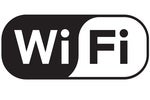


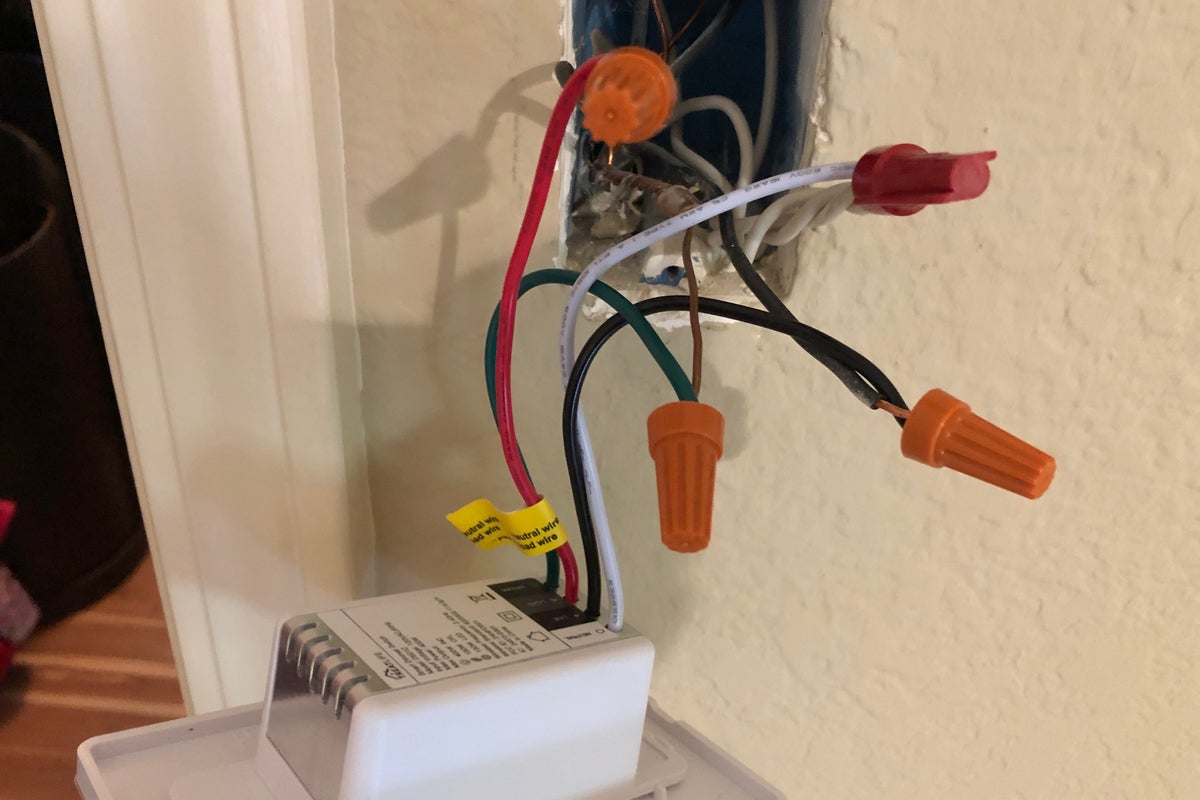





Leave a Reply